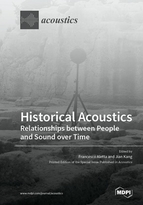Historical Acoustics: Relationships between People and Sound over Time
A special issue of Acoustics (ISSN 2624-599X).
Deadline for manuscript submissions: closed (30 November 2019) | Viewed by 89713
Special Issue Editors
Interests: environmental acoustics; soundscape; community noise; noise annoyance; urban planning; environmental design; environmental assessment; landscape design
Special Issues, Collections and Topics in MDPI journals
Interests: environmental acoustics; building acoustics; soundscape; noise control
Special Issues, Collections and Topics in MDPI journals
Special Issue Information
Dear Colleagues,
Sounds are physical phenomena filled with information content that have helped mankind to make sense of the world and finding its way over centuries, since the beginning of time. While the establishment of “acoustics” as the science of the “production, transmission and effects of sound” in our modern understanding could be determined to have happened approximately two-hundred year ago, scientific acoustical studies date back to the 6th century BC, with the ancient Greek philosophers, and were developed later on by Roman architects and engineers. In fact, the interest human communities have shown towards acoustical phenomena goes back much more than that, for which recent research outcomes from archaeoacoustics, investigating the auditory and acoustic environment of prehistoric sites and monuments, have been very fruitful. Indeed, societies and cultures have been more or less aware of the importance of “sound” and the science underpinning it, and acoustics have always played a central role for our lives and evolution.
This Special Issue, as the first Special Issue of this newly-established journal, seeks to explore the origins of acoustics, by examining relationships between people and sound over time. It aims at gathering contributions from a broad range of topics related (but not limited) to: Acoustic characterization of prehistorical and historical spaces and buildings, acoustics of worship spaces (e.g., temples, mosques, churches, etc.) and ancient theatres, auralization of soundscapes of the past, soundscape of heritage sites and sound as cultural heritage, and literature reviews about acoustic treaties.
Prof. Jian Kang
Dr. Francesco Aletta
Guest Editors
Manuscript Submission Information
Manuscripts should be submitted online at www.mdpi.com by registering and logging in to this website. Once you are registered, click here to go to the submission form. Manuscripts can be submitted until the deadline. All submissions that pass pre-check are peer-reviewed. Accepted papers will be published continuously in the journal (as soon as accepted) and will be listed together on the special issue website. Research articles, review articles as well as short communications are invited. For planned papers, a title and short abstract (about 100 words) can be sent to the Editorial Office for announcement on this website.
Submitted manuscripts should not have been published previously, nor be under consideration for publication elsewhere (except conference proceedings papers). All manuscripts are thoroughly refereed through a single-blind peer-review process. A guide for authors and other relevant information for submission of manuscripts is available on the Instructions for Authors page. Acoustics is an international peer-reviewed open access quarterly journal published by MDPI.
Please visit the Instructions for Authors page before submitting a manuscript. The Article Processing Charge (APC) for publication in this open access journal is 1600 CHF (Swiss Francs). Submitted papers should be well formatted and use good English. Authors may use MDPI's English editing service prior to publication or during author revisions.
Keywords
- Historical acoustics
- Archaeoacoustics
- Ancient theatres
- Worship acoustics
- Soundscapes of the past
- Cultural heritage
Related Special Issue
- Historical Acoustics in Acoustics (17 articles)







